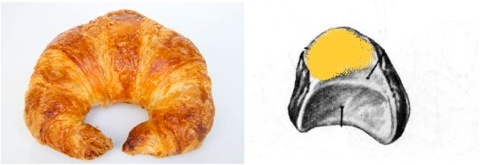Last week marked the arrival of the “super moon”, the rare coincidence of a full moon phase with the point in its orbit at which the lunar body is closest to the Earth. In order, no doubt, to stimulate public interest in astrophysics and astronomy, researchers have enthusiastically proclaimed that “the real size difference isn’t big enough to notice” and “it won’t fill the sky”. Astronomers: The killjoys of Science!

Left: Left lunate, view from the scaphoid, palmar is up.
Right: Crescent Moon, viewed from the Earth, presumably.
However, in order to rectify their dearth of exuberance, I give you a post on the lunate, one of the easiest carpals to identify and side. In sharp contrast to the super moon, the lunate is shaped like a crescent moon, and is accordingly difficult to confuse with any of the other carpals. Though one could argue that the scaphoid demonstrates a similar curvature, the lunate is much smaller and lacks the distinctive proximal concavity (for articulation with the capitate) and distal convexity (for articulation with the radius) of the scaphoid. Also, as we’ve discussed previously, the scaphoid is easily identifiable because it looks like a snail.
Siding Tips: When you find a lunate, orient it so that its most convex and rugose surface points away from you – rather as if it was a croissant you were about to tuck into. I must emphasize that the pastry metaphor isn’t really straying from the lunar theme, since etymologically speaking, croissant and crescent stem from the same root. Once oriented thusly, make sure that the surface containing the articulation for the triquetral is facing up. This is easy to differentiate from the less well-defined, more rainbow-shaped arc of the scaphoid articular surface, for the triquetral articulation is small, flat, well-delineated and half-circular – as indicated in yellow in the photo above. This articulation will fall to the side the bone is from!




Nice post, but you have made a serious error that I absolutely must draw to your attention. You have highly improperly suggested that there is a single, natural way to orient a croissant prior to its consumption. Please correct this egregious error and try again. 🙂
LikeLike
Pingback: Osteology Everywhere: Lithic Edition | Bone Broke